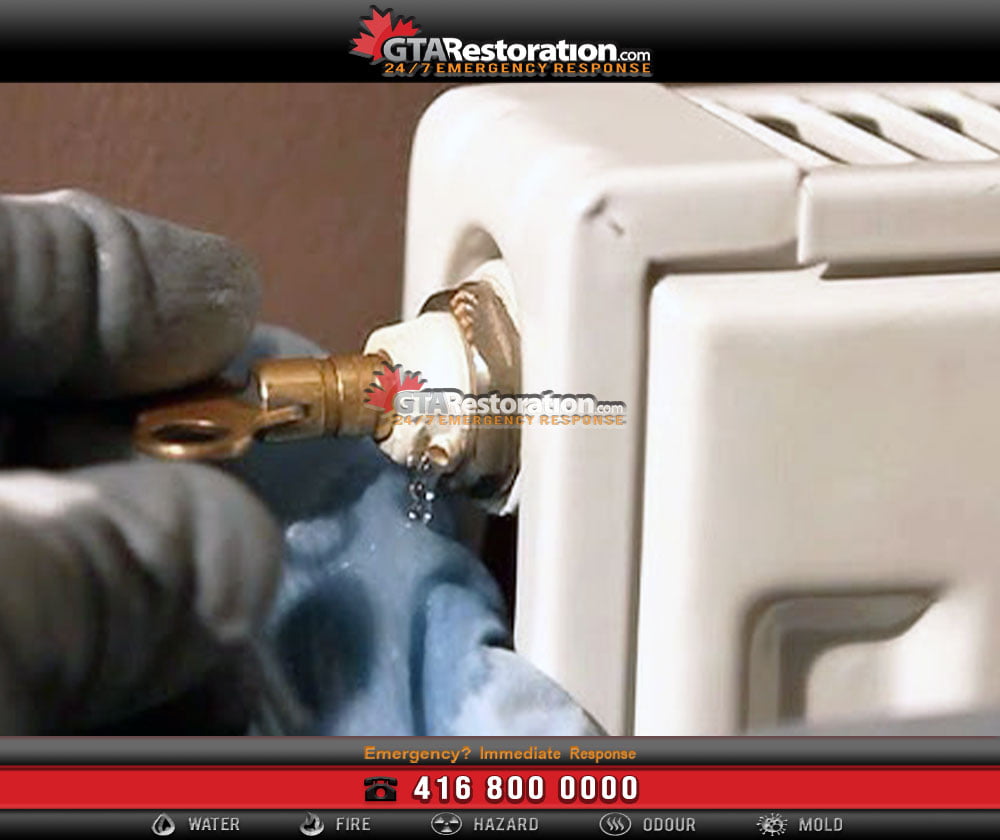
Thermostatic Radiator Valve: Why you should fit them in your Property.
A thermostatic radiator valve is a self-regulating valve that controls the heat of an individual radiator in a home.
The advantage of a radiator thermostatic valve is that they can balance the heat in every room of your house. Without them, heat is distributed throughout the house depending on the temperature of the thermostat room.
Room temperatures can vary for a number of reasons, including the number of people in the room and the time of day. The sun can shine through the bedroom window in the morning and into the living room in the evening, creating a greenhouse effect in these rooms. That is why it is useful to use a thermostatic valve, because it regulates the radiator according to the room temperature.
As the room temperature rises, the valve slowly closes, limiting the amount of water entering the radiator, thus limiting the heat released, this way you can set the maximum room temperature, for example, in a spare room that is not used very much, you can set a very low temperature.
Digital radiator thermostat valves are now available which are more efficient and cost effective as you can set the desired temperature based on the time of day. This way, you can adjust the temperature of your home so that it is cozy and warm when you get home from work and a little cooler when you go to bed.
Thermostatic radiator valves are not very expensive, from $13 to $160. Thanks to their cost-effective self-regulation, they save you around 17% per year on your heating bill, so you can make your money back in just a few years, They are also an option for those who are environmentally conscious when it comes to reducing carbon emissions.
Top Tip: When removing the radiator (e.g. to decorate or flush the radiator) make sure you put the valve end of the thermostat into the cover that came with the thermostat. If the radiator is removed and the end of the thermostat is left inside the valve, the thermostat will automatically open when the temperature drops, allowing water to flow onto the floor.

Thermostatic Radiator Valves: A Comprehensive Guide
Introduction to Thermostatic Radiator Valves (TRV)
Thermostatic Radiator Valves (TRV) are innovative components in modern home heating systems designed to improve energy efficiency and precisely control temperature. These self-regulating valves are installed in radiators and their main function is to regulate the flow of hot water to the radiator according to the room temperature. By maintaining an even and comfortable temperature, TRVs contribute significantly to the overall heating efficiency of the home.
The concept of radiator thermostatic valves is based on their ability to automatically regulate the heat of the radiator. Each TRV is equipped with a temperature-sensitive element, usually a wax or liquid-filled capsule, that expands or contracts with temperature changes. This movement adjusts the valve to increase or decrease the flow of hot water through the radiator, thus regulating the temperature of the room without manual intervention.
TRVs generally consist of three main components: a sensor head, a valve body, and a needle. The sensor head contains a temperature-sensitive element, the valve body is connected to the radiator and controls the flow of water. The pin connects the sensor head to the valve body, converting sensor movements into valve settings. With this simple but effective mechanism, TRVs can effectively maintain the desired room temperature.
The historical development of radiator thermostatic valves dates back to the middle of the 20th century, with major advances occurring in the 1970s and 1980s. At first, these valves were relatively simple, but later evolved into sophisticated devices that use advanced materials and techniques to improve their efficiency and reliability. Today, TRV is an integral part of many home heating systems, offering homeowners a practical solution to improve energy efficiency and comfort.
Understanding the basic operation and benefits of thermostatic valves is very important for anyone who wants to optimize their home heating system. By integrating TRVs into their radiators, homeowners can achieve better temperature control and lower energy consumption, ultimately leading to cost savings and a greener home.
How TRVs work
Thermostatic radiator valves (TRVs) are advanced devices designed to regulate the temperature of individual radiators, increasing energy efficiency and comfort in the home or office. At the heart of their functionality is a combination of mechanical and scientific principles that ensure precise temperature control.
The main components of TRV are sensor, valve actuator and adjustment wheel. The sensor, often filled with a temperature-sensitive liquid or wax, plays a vital role in detecting the temperature of the ambient air in the room. When the room temperature changes, the sensor expands or contracts, triggering the valve actuator.
A valve actuator connected to a sensor controls the opening and closing of the valve. When the sensor detects that the room temperature has reached the desired level set by the control dial, it signals the actuator to partially or completely close the valve. This action reduces the flow of hot water to the radiator, which prevents overheating and maintains a constant temperature.
Conversely, when the room temperature drops below the set level, the sensor contracts, causing the valve actuator to open the valve wider. This increases the flow of hot water to the radiator and increases the room temperature to the desired setting. This dynamic response ensures that the optimal temperature is maintained in each room without unnecessary energy consumption.
The setting dial allows users to manually set the desired temperature. Marked with numerical or symbolic pointers, the dial provides an easy way to adjust the TRV to individual comfort levels. Finally by adjusting the setting dial, users can achieve precise temperature control, improving both comfort and energy efficiency.
Understanding how thermostatic valves work is important to understanding their benefits. Using the principles of thermal expansion and contraction, TRVs offer a practical solution to maintain a constant temperature, optimizing both comfort and energy use in heating systems.

Benefits of Using a TRV
Thermostatic radiator valves (TRVs) play a key role in optimizing home heating systems and offer a number of benefits that increase both comfort and efficiency. One of the most important benefits of installing TRVs is their ability to significantly improve energy efficiency. By enabling individual room temperature control, TRVs prevent unnecessary heating and ensure that energy is not wasted in empty spaces. This precise temperature control means significant savings on heating. According to research by the Energy Saving Trust, households using TRV can save up to 10% of their annual heating costs.
In addition to financial savings, TRVs add a more comfortable living environment. Each valve can be set to the desired temperature, which corresponds to the comfort level of different rooms. This customized approach eliminates the common problem of some rooms being too hot while others remain cold, ensuring a consistent and comfortable indoor climate.
Environmental benefits are another compelling reason to consider TRV. By increasing energy efficiency, TRVs help reduce overall heating demand, which reduces greenhouse gas emissions. This reduction in energy consumption directly translates into a smaller carbon footprint. Studies show that the widespread adoption of TRV in residential buildings can significantly reduce carbon dioxide emissions and contribute to the fight against climate change.
Case studies have demonstrated the tangible impact of TRV on energy consumption and cost savings. For example, a UK government social housing project found that installing TRVs, along with other energy saving measures, reduced energy consumption by 15%. Such information emphasizes the practical benefits and environmental importance of integrating TRV into domestic heating systems.
All in all, using thermostatic valves offers many benefits, from better energy efficiency and cost savings to better comfort and environmental sustainability. These advantages make TRV an indispensable part of modern environmentally conscious home heating solutions.
Types of TRVs
There are several types of Thermostatic Radiator Valves (TRVs), each with different functions tailored to different heating requirements and user preferences. The main categories include manual, electronic and smart TRVs, each with unique benefits and applications.
Manual TRVs are the simplest type, allowing users to manually adjust the temperature of individual radiators. By turning the valve, you can direct the flow of hot water to the radiator and thus regulate the room temperature. These valves are inexpensive and easy to install, making them a popular choice for homeowners looking for an easy solution. However, manual TRVs lack the precision and automation that more advanced types offer.
However, electronic TRVs offer better control and comfort. These valves are equipped with electronic sensors that monitor the room temperature and automatically adjust the flow of hot water. Electronic TRVs, often equipped with digital displays, allow more accurate temperature readings and improve energy efficiency. Leading brands like Honeywell and Drayton offer reliable electronic TRVs that are both easy to use and effective at maintaining a consistent room temperature.
Intelligent TRVs represent the pinnacle of modern heating control. These valves can be integrated into home automation systems, allowing users to remotely control the heating using smart apps. Smart TRVs not only adjust temperatures based on real-time data, but also learn user preferences over time, optimizing heating schedules for maximum efficiency. Popular models from brands like Tado and Netatmo offer advanced features like geofencing, voice control compatibility, and detailed energy usage reports. These smart solutions are ideal for tech-savvy homeowners who want to improve the performance and comfort of their heating system.
Each type of TRV has its own advantages, so it’s important to consider your specific needs and preferences when choosing a valve. Whether you want simplicity, precision or smart home integration, we have a thermostatic valve to suit your needs.

TRV Installation and Maintenance
Installing Thermostatic Radiator Valves (TRV) is a simple process that can greatly improve the efficiency of your heating system. First, make sure you have the tools you need, including adjustable wrenches, pipe cutters, and PTFE tape. Before installation, turn off the heating system and let the radiators cool completely. This precaution prevents burns or leaks during the process.
First drain the radiator by closing the valves on both sides and removing the remaining water with a drain pan. Remove the existing valve with an adjustable wrench and clean the threads of the radiator hose. Wrap PTFE tape around the threads to seal the new TRV. Attach the TRV to the radiator and make sure it fits snugly and securely.
After installation, fill the cooler and restart the heating system. Check for leaks initially by operating the system at low temperature. If you notice any leaks, tighten the connections as needed. To ensure that TRVs remain in optimal working order, it is recommended that they be inspected regularly.
TRV maintenance is minimal but critical to their effectiveness. Clean the valves regularly to prevent the accumulation of dust and debris that can affect their sensitivity. It is also important to regularly check for leaks and make sure that furniture or curtains are not blocking the valves. These simple steps can extend the life of your TRVs and keep them running.
If you have problems with your thermostat valves, such as a radiator not heating or a valve being stuck, troubleshooting can often solve these problems. A gentle tap on the valve can clear internal blockages, and proper ventilation of the radiator helps maintain even heating. If problems persist, it may be necessary to consult a specialist to prevent damage to the system.
Common Misconceptions About TRVs
Thermostatic Radiator Valves (TRVs) are often misunderstood, leading to a number of misconceptions that can prevent potential users from understanding their benefits. One common myth is that TRVs are not effective at controlling room temperature. Contrary to this belief, TRVs are designed to maintain a consistent and comfortable temperature by adjusting the flow of hot water to the radiator according to room temperature. It ensures efficient heating of every room in the home or building and prevents overheating and hypothermia.
Another common misconception is that TRV installation is prohibitively expensive. Although there are upfront costs associated with purchasing and installing these valves, the long-term savings on energy bills can outweigh these costs. TRVs help reduce energy consumption by avoiding unnecessary heating, which ultimately lowers operating costs. Various studies and expert opinions support the claim that TRVs can provide significant energy savings, making them a cost-effective investment over time.
Compatibility with different heating systems is another area where misunderstandings arise when it comes to TRV. Some believe that TRVs are only suitable for certain types of heating systems. However, TRVs are versatile and can be integrated into a wide variety of systems, such as traditional boilers, modern condensing boilers and even renewable energy sources such as heat pumps. This adaptability makes TRV a valuable addition to almost any heating arrangement, improving its efficiency and effectiveness.
Finally, there is a common misconception that TRVs require frequent maintenance or are prone to malfunction. In reality, TRVs are relatively low maintenance devices. They are designed to be durable and reliable, and many models come with a long warranty. Regular inspection and occasional cleaning can ensure optimal performance, but extensive maintenance is rarely necessary.
By debunking these myths and providing accurate information, it is clear that radiator thermostatic valves are an effective, cost-effective and compliant solution to improve heating efficiency. Understanding the real benefits of TRVs can help people make informed decisions about incorporating these devices into their heating systems.

TRVs in different climate zones
Thermostatic radiator valves (TRVs) are very versatile in different climate zones, which is why they are an indispensable part of modern heating systems. Their ability to adapt to different weather conditions increases energy efficiency and comfort, whether you live in a cold or temperate climate.
TRVs prove particularly useful in cold regions. In severe winters, maintaining a constant internal temperature is very important. TRVs automatically adjust the heat of the radiators according to the room temperature, ensuring that each room is heated to the desired level without overheating. This not only saves energy, but also lowers the heating costs of the apartment. For example, in Scandinavian countries, where winter temperatures can drop significantly, TRVs are widely used to maintain optimal heat and minimize energy consumption.
On the other hand, in temperate climates where weather conditions vary throughout the year, TRVs offer several advantages. They allow homeowners to dynamically adjust heating according to changing outdoor temperatures. In mild winters or colder autumn days, TRVs can prevent unnecessary heating and thus save energy. In the UK, known for its unpredictable weather, TRVs allow homeowners to fine-tune their heating systems and ensure comfort without excessive energy consumption.
In addition, TRVs are useful in transitional climate zones where seasonal changes can be abrupt. For example, in areas of North America where seasonal changes are evident, TRVs can seamlessly adapt to the heating needs of each season. Homeowners can set different temperatures in different rooms according to individual preferences and usage habits. This zone heating feature is especially useful in larger homes where different areas may have different heating needs.
In short, the suitability of thermostatic valves for different climate zones emphasizes their importance in optimizing heating systems. Dynamically responding to environmental conditions, TRVs help maintain indoor comfort and improve energy efficiency, making them a valuable addition to any home, regardless of climate.
Thermostatic Radiator Valve Emergency?
Call Today!
1-800-506-6048
Learn more ↴
Restoration Group, How to deal with carpet water damage?, Burst Pipe Repair – Frozen Pipes Edmonton, How to Prevent Burst Pipes from Freezing Winter?, Frozen pipe & how to prevent them?, Commercial Garage Roof Repair & Waterproofing,












